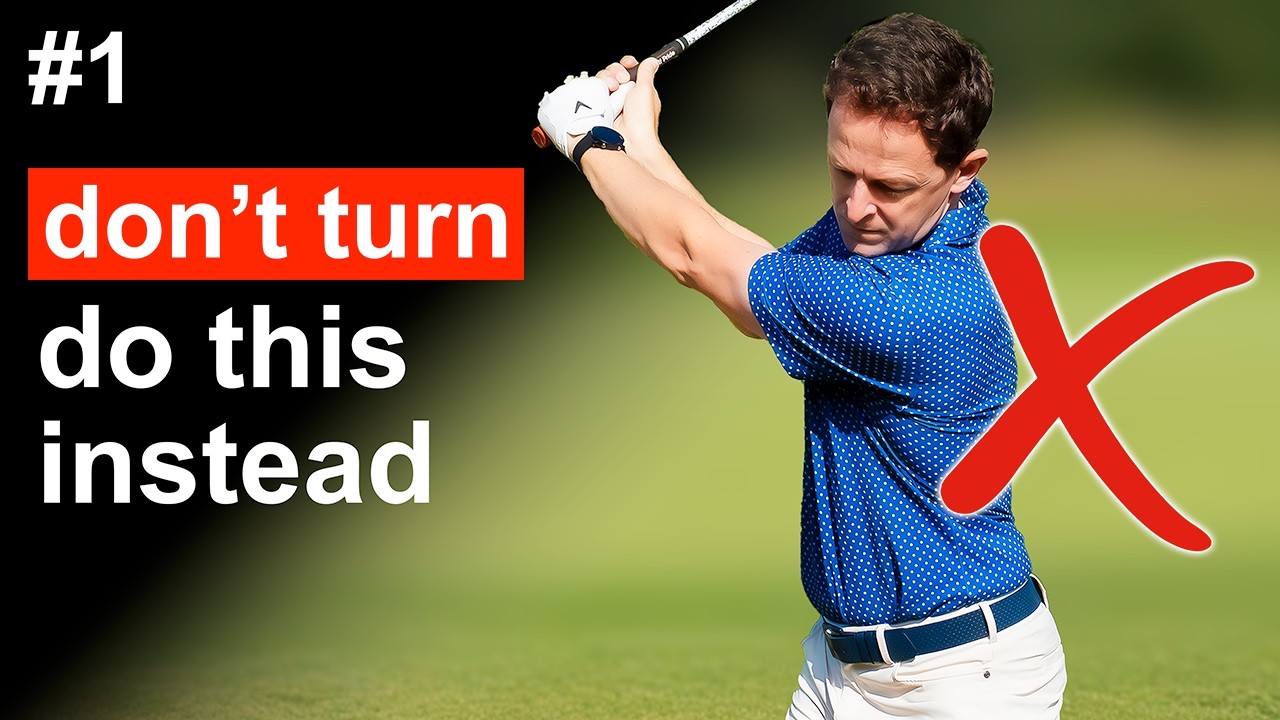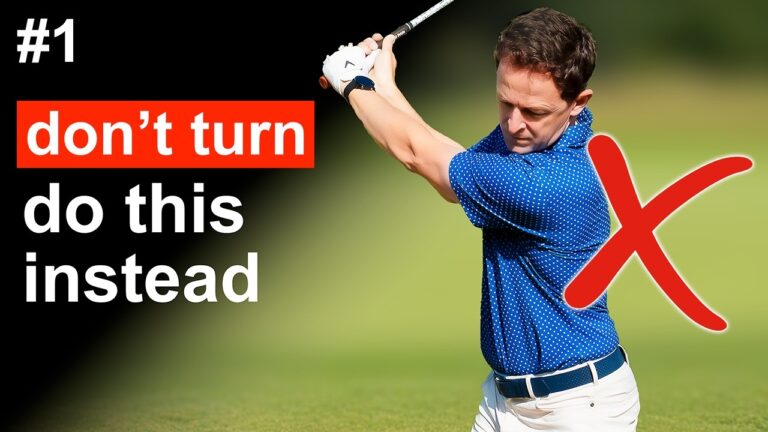
Mastering your golf swing doesn’t require long hours on the course. With just six minutes a day, you can see significant improvement in your swing stability, power, and accuracy.
Practice makes permanent. Engaging in proper practice is vital; permanently practicing incorrect techniques will groove faults into your swing that are hard to fix. If you’re slicing the ball or struggling to achieve consistent contact, just a few minutes of focused practice can change all that.
This guide offers practical golf swing tips you can practice indoors, in your garden, or at the range. Spend six minutes a day on these tips, and you’ll develop the right feelings, build useful muscle memory, and start hitting longer, straighter shots.
Table of Contents
- Step 1: Feel the Backswing
- Step 2: Master the Transition
- Step 3: Blend the Backswing and Transition into a Flowing Motion
Step 1: Feel the Backswing
The first essential skill is feeling the right ways to turn away from the ball. Many golfers tend to make a complete turn where their knees, hips, torso, and feet rotate together, but this often results in a lack of generated power.
Why This Matters
- Correct resistance into your trail leg generates stored energy, which can be released effectively during the transition and downswing.
- A full body turn without proper resistance reduces torque and clubhead speed, resulting in weaker strikes.
- Proper loading fosters better body balance and a more ground-reliant downswing.
How to Feel It
Adopt a stance like you’re about to hit a ball, but instead of letting your entire trail leg pivot away, maintain pressure on the inner portion of your trail foot. Visualize twisting your zipper toward the trail leg, as if you’re subtly ‘crushing’ the ground beneath your trail foot. Your knees should remain stable and forward-facing rather than fully rotating outward.
Drill Instructions (2 Minutes)
- Set up as if you’re about to hit a shot, starting without a club.
- Perform a slow backswing, maintaining pressure on the inside of your trail foot, and resist pivoting the leg away completely.
- Visualize a zipper on your chest turning toward the trail leg as you load the backswing.
- Pause at the top for a couple of seconds to sense tension in the trail thigh and stability in the lead leg.
- Repeat 20 to 30 slow reps, concentrating on the sensation of loading rather than speed.
Progression
- After completing two sets of 20 reps without a club, introduce a short swing with a mid-iron or weighted training aid, maintaining the same loaded sensation.
- Gradually quicken the pace while preserving the feeling of trail leg loading, ensuring the sensation remains even as speed increases.
Common Mistakes and How to Avoid Them
- Collapsing Trail Leg: If your trail knee folds inward, refocus on pressing into the inner trail foot and stabilizing the knee.
- Over-Rotating: Avoid letting your entire body rotate uniformly and spinning your feet freely, as this eliminates stored energy.
- Excessive Tension: Aim for controlled tension, not rigid joints. The goal is to foster elastic and ready-to-release power.
Immediate Gains
Improving trail leg loading often results in increased connection and better downswing initiation, as the lower body forms a springboard for initiating energy in your swing.
Step 2: Master the Transition
Mastery of the transition involves understanding the motion at the top of your swing and during the initial descent. Elite players engage in a slight forward movement before rotating toward the target, combined with a strategic trail heel lift.
The Two Key Elements
- Forward Shift: A subtle shift of the center of mass toward the lead side before significant rotation.
- Trail Heel Lift: Allow the heel to move upwards, creating space for a hip rotation that doesn’t spin the lower body.
Practicing the Transition
Mirroring the zipper cue from Step 1, reverse it by pushing the zipper toward your lead leg as you transition. Avoid aggressive sliding and instead push in a controlled manner to move the weight forward.
Drill Instructions (2 Minutes)
- Start from the loaded backswing position in Step 1, sensing the trail leg.
- Initiate the transition by pushing your zipper toward the lead leg while keeping the lead foot firm.
- Let your trail heel lift slightly before rotating your hips, creating room for movement.
- Hold the lead leg’s tension to embed the feeling of proper transition dynamics.
- Perform 20 to 30 repetitions, slowly first, then increasing speed as you get comfortable with the mechanics.
Troubleshooting Key Issues
- Spinning Out: Prevent premature rotation by focusing on an initial forward push.
- Inward Lead Foot Twist: Maintain stable knees, ensuring the lead foot doesn’t twist.
- Lack of Forward Movement: Encourage a sequenced forward push, ensuring an efficient kinetic chain.
Power and Contact Benefits
A proper transition facilitates an efficient energy transfer that stems from the ground up, fostering a more potent and accurate swing.
Step 3: Blend the Backswing and Transition into a Flowing Motion
Combining these two distinct sensations — the trail leg load and lead leg push — into a cohesive and smooth swing is crucial for creating an effortless flow.
What Blending Looks Like
During the movement sequence, your body should reset to an address-like posture, slightly advanced toward the target. This position allows optimal strike mechanics, minimizing flipping or scooping issues.
Drill Instructions
- Begin with a slow backswing, ensuring a loaded trail leg as described in Step 1.
- Initiate the transition by pushing the zipper into the lead leg, letting the trail heel elevate gently.
- Adjust to a reset position that’s akin to your address stance before advancing toward the impact point.
- Accelerate smoothly into a full finish, emphasizing balanced lead leg pressure.
- Complete sets of 10 slow swings, gradually upping speed as coordination improves.
What This Solves
- Slicers: Minimizes spin-out tendencies, refining the swing path.
- Hookers: Guards against sliding beneath the ball and promotes correct impact positions.
- Contact Issues: Promotes consistent sequencing, optimizing club positions at impact.
Tracking Correct Execution
- Your knees should mimic address angles during impact.
- Lead thigh engagement and a natural trail foot progression are essential.
- Well-executed shots should feel smooth, with minimal exertion required for distance.
Advanced Tip:
Focus on the flow of the movement, building confidence in the sequence rather than prioritizing speed. Avoid rushing; feel the sensation fully to engrain the movement.
6-Minute Daily Practice Plan
Consistency over time enhances results. Execute this brief, focused practice three to five times a week for best results.
- Minute 0-2: Trail leg loading drill. Complete two sets of 10 without a club, followed by 10 with a short iron.
- Minute 2-4: Transition pushes into the lead leg. Two sets of 10 reps. Use the heel lift and hip turn cues effectively.
- Minute 4-6: Blend the movements with two sets of 5 to 10 comprehensive swings.
Troubleshooting Common Faults
- Slicing: Prioritize trail leg loading and lead leg pushing to fortify swing path.
- Hooking: Avoid unnecessary lateral movement by ensuring correct setup angles before advancing.
- Poor Contact: Employ the drills at a slow pace until muscle memory embeds correct mechanics.
Measuring Progress
- Observe improvements in shot accuracy and control.
- Monitor distance enhancements to gauge better energy transfer.
- Ensure consistent contact quality with more turf interaction.
- Seek less effort to achieve high speed, indicating efficiency gains.
Integrating a Full Practice Session
Augment daily drills with longer sessions to refine technique and comfort during full-speed swings.
- Daily: 6-minute drill to maintain movement precision.
- Twice a Week: Simulate game scenarios, aiming for feel and accuracy in a longer session.
- Weekly: Record or seek coaching assistance to ensure sequence retention in full-speed execution.
How long before I see improvement using these golf swing tips?
Even a single session focusing on sensations can yield small improvements. More substantial changes emerge after consistent daily practice over a few weeks.
Do I need a training aid or can I practice without any equipment?
No specialized gear is needed; visualize cues and practice club-less drills or use an ordinary club. Incorporate aids if you find additional visual or tactile feedback helpful.
Can these drills help a beginner and an experienced player?
Yes, beginners can build effective foundational skills to prevent bad habits, whereas experienced players can refine their technique and resolve ingrained issues.
How do I know if I am pushing into the lead leg correctly?
You should experience tension in the lead thigh, a forward mass shift, and minimal lead foot inward twisting. Correct adjustments reduce lateral sliding tendencies.
Will this technique increase my driver distance?
Yes, enhancing ground reactions and sequencing elevates clubhead speed and shot efficiency, likely increasing carry without requiring harder swings.
What should I do if I feel pain in knees or back while practicing?
Discontinue and assess your movements. Controlled tension might reveal mobility limits. Adjust range or consult professionals to address the issue.
Final Thought
Embrace these impactful golf swing tips to effect major improvements in efficiency, distance, and confidence. The sequence — load, push, and blend — is straightforward yet transformative. Dedicate just two minutes daily to each drill, build competency, and gradually increase speed for progress.


0 Comments